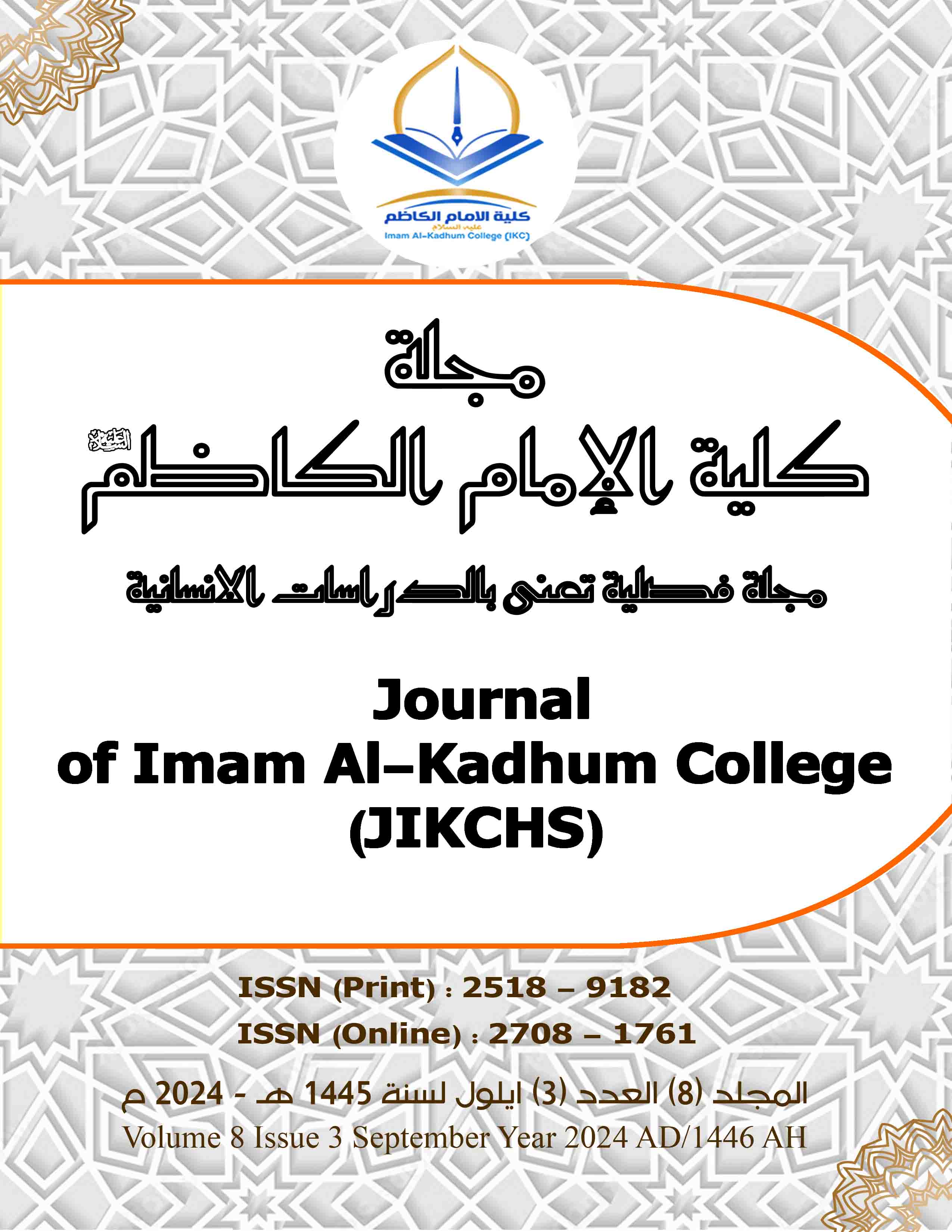أثر استخدام استراتيجية مثلث الاستماع على تحصيل طلبة الجامعات العراقية في مقررات تقييم اللغة
DOI:
https://doi.org/10.61710/gr1qkd47الكلمات المفتاحية:
مثلث الاستماع, الاستراتيجية . التقيم , الاختباراتالملخص
(LTS)لزيادة اكتساب المعرفة والفهم لدى طلاب الجامعات العراقية الذين يدرسون مادة التقييم والاختبار باللغة الانكليزية
الطريقة(المنهج):- اجريت تجربة لتحقيق اهداف الدراسة، اذ تم تحديد النتائج باستخدام الاختبار التأي والعينة هم من طلبة المرحلة الرابعة لقسم اللغة الانكليزية في كلية الامام الكاظم ع للعام الدراسي 2023/2024 وتم اختيار ستين طالبا وطالبة وتقسيمهم عشوائياً الى مجموعتين . المجموعة أ :- وهي المجموعة التجريبة مكونة من 30 طالباً استخدمنا فيها استراتيجية مثلث الاستماع في دراستهم المجموعة ب :- وهي المجموع الضابطة مكونة من 30 طالبا واتبعتُ فيها طرق التعلم التقليدية ولتحقيق اهداف الدراسة قامت الباحثة بتطوير اختبارين اختبار قبلي واختبار بعدي مكون من سؤال واحد وفق اختيار من متعدد واجب بعلامة صح او خطأ مكون من 10 فقرات في موضوع التقييم والتأكد من صدقه وثباته الاختبار تم عرضه على مجموعة خبراء من المحكمين في مجال تدريس اللغة الانكليزي وعلم اللغة النتائج:- اظهرت نتائج الاختبار البعدي ان مجموعة (أ) التجريبة ا ( 277) اعلى تحصيل من المجموعة (ب) الظابطة (25.2)وكان هذا الفرق ذو دلالة احصائية ، ولذلك ترفض الفرضية الصفرية وتقبل الفرضية البديلة بمعنئ اخر يمكن ان تساعد استرتيجية مثلث الاستماع الطلاب على تحسين مهارات الاستماع والتحدث لديهم ؛مما يؤدي بدوره الى زيادة فهمهم للموضوعات القائمة على التقييم والاختبارات.
الخلاصة :- اظهر البحث اهمية تدريس مواد التقييم نتيجة استخدام استراتيجية مثلث الاستماع ويجب التركيز على دورات اضافية على تطبيق هذه الطريقة في التعليم العام.
المراجع
REFERENCES
Al-Bawi, Magda Ibrahim and Thani Hussein Al-Shamri (2020), Contemporary Models and Strategies in Teaching and Evaluation, Edition 1, Dar Al-Amal Al-Jadida for Printing and Publishing
Al-Kaabi, Balasim Kahit Hassan (2016), The effect of the listening triangle strategy in the achievement of geography and the development of scientific thinking skills for first-grade intermediate students, Al-Ustad
MCkINNEY, m. A. & dRAKE, j. A. (eds) 1998. Biodiversity dynamics. Turnover of Populations, Taxa, and Communities. xx+528 pp. New York: Columbia University Press.
Abu Al-Haj, Suhad Hassan and Al-Musalha ,Hassan Khalil (2016) Active Learning Strategies, Debno Center for Teaching Thinking press, Dubai, United Arab Emirates.
Ambo Saidi, Abdullah Khamis and Huda Bint Ali Al Hosani (2016), Active Learning Strategies, 1st Edition, Amman, Dar Al Masirah for Publishing and Distribution.
Attia, Mohsen Ali (2018), Active Learning, Modern Strategies and Techniques in Teaching, 1st Floor, Dar Al-Shorouk, Amman, Jordan
Bligh, D. A. (2000). What's the use of lectures? (1st Ed.). San Francisco: Jossey- Bass Publishers.
Burden, P.R. & Byrd, D.M. (2010). Methods for Effective Teaching, Meeting the needs of All Students. London: Pearson Education.
Eison, J. (2010). Using active learning instructional strategies to create excitement and enhance learning. Retrieved October 20, 2017 from The Center for Teaching Excellence at Cornell University.
Ganyaupfu, E. M. (2013). Teaching methods and students’ academic performance. International Journal of Humanities and Social Science Invention. 2(9), 29-35.
Huba and Freed (2000) (Learner-Centered Assessment on College Campuses: shifting the focus from teaching to learning) Retrieved December 2, 2023 from https://www.westminster.edu/about/accreditation-assessment/definition.cfm
McKeachie, W. J., & Svinicki, M. (2006). McKeachie’s teaching tips: Strategies, research, and theory for college and university teachers. Boston: Houghton-Mifflin.
Richards, J. C. & Rodgers, T. S. (2014). Approaches and methods in language teaching. Cambridge: Cambridge University Press.
Richards, Jack, C. and Willy Renandya. 2002.Methodology in Language Teaching: An Anthology of Current Practice. London: Cambridge University Press.
Paul, A. M. (2015). Are college lectures unfair? Sunday Review. New York Times. Retrieved 20 October 2017.
Novak G. M., Gavrin A., Patterson E. T. (2004). Just-In-Time teaching. Retrieved September 2, 2017 from http://webphysics.iupui.edu/jitt/jitt.htm
Appendixes (A ) pre-test
Q./Choose the correct answer
It seeks to provide evidence of the learning outcomes for reporting and decision-making purposes.
a. alternative assessment b. summative assessment b. formative assessment
These are easier to mark than to set and permit a wide coverage.
a. subjective questions b. objective questions c. semi-objective questions
Students are required to show their understanding to the materials that are presented by selecting the right boxes.
a. grid b. labeling c. gap filling
It requires the students to combine many elements when completing the task.
a. discrete test b. holistic test c. indirect test
There is no real distinction between test and exercise in:
a. easy translation approach b. structural approach c. communicative approach
Is used for measuring the ability to identify the correctness of statements, facts ect.
a. odd one out b. matching c. true/ false
Criterion reference assessments are concerned with
a. content of the test b. interpretation of the scoring of test c. developing of the test.
The best example of an open ended format is
a. composition writing b. MCQ c. matching questions
In multiple choice items, the initial part of the item is:
a. correct answer b. incorrect choices c. stem
“Underline the incorrect word’’ such question form can be used in
a. transformation b. matching c. error recognition
Appendixes (B ) post-test
Q./ Answer with (true) or (false) and correct the false ones.
Informal assessment is large scale test and administered in controlled environment.
Within essay –translation approach the tests were mainly spoken exercises.
Gap filling is useful for testing student’s ability to produce sentences by changing sentence structure from into another.
There is no real distinction between test and exercise in structural approach of testing.
Even though we use communicative language approach in teaching and assessment, the majority of tests still adhere to the structural approach.
Guided writing question is an example of RRQ.
Informal assessment is large scale test and administered in controlled environment.
Within essay –translation approach the tests were mainly spoken exercises
The scoring of open ended questions take a long time.
Rearrangement testing technique can successfully measure a student's syntactic and semantic command of the language.
التنزيلات
منشور
الرخصة
الحقوق الفكرية (c) 2024 Journal of Imam Al-Kadhim College

هذا العمل مرخص بموجب Creative Commons Attribution-NonCommercial-NoDerivatives 4.0 International License.





